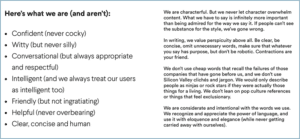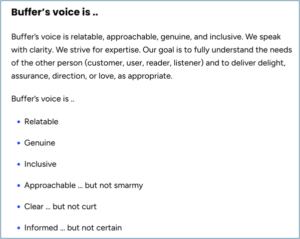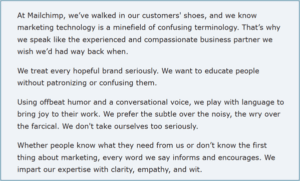A strong, consistent brand voice is the foundation of successful business communication. When used across platforms and content types, your brand voice helps shape how your organisation interacts with its audience by building brand recognition and differentiation, fostering customer engagement and enhancing credibility. Without a unified approach, a brand can appear confused, unprofessional and even untrustworthy.
However, maintaining consistency can be tricky for organisations with numerous individuals and teams creating content at any given time. We often encounter this when we edit jobs for clients with multiple authors, like annual reports and sustainability reports. In fact, ensuring copy is clear, consistent and on-brand is a core part of what we do at Editor Group.
What is brand voice?
Brand voice refers to the distinct personality a company embodies in its written and spoken communication. This usually reflects a brand’s identity, values and mission and aligns with its audience’s needs and preferences.
For instance, a tech startup may have a confident yet approachable brand voice, while a health and wellness brand might aim to convey calm supportiveness.
Productivity platform Slack believes the key to sounding like them is “speaking directly to the user in a voice that they can hear and recognise”. Here’s what they have to say about their brand voice.

And here’s how they put it into practice.

Regardless of the specifics, strong brand voices are distinctive, authentic and cohesive across platforms and content types.
Brand voice is different from tone, which can change depending on the situation, audience or platform you’re writing for. This means that while a business may have a friendly and professional voice, its tone may shift depending on the purpose of the content. A business’s website copy may be confident and informative, for example, while its customer support emails may be more empathetic and helpful.
By maintaining a consistent brand voice while adjusting tone, you can ensure your content is cohesive and contextually relevant.
Having helped many of our clients remain true to their brand voice, here are our strategies for ensuring your team maintains a consistent voice across different platforms and types of content.
Clearly define your brand voice
To write content that accurately reflects your brand, writers must first understand your brand voice. If your brand voice is unclear, individual team members might interpret it differently, opening the door to inconsistencies. This is why it’s essential to define your brand voice in an easy-to-implement way.
Start by identifying your brand’s personality. If your brand were a person, how would you describe its personality? What adjectives best capture the way your brand communicates? For example, authoritative, friendly, witty, professional or innovative. Clearly articulating these attributes is helpful for writers seeking to align their content with your brand’s personality.
A brand voice statement is also helpful. This is a concise definition of how your company communicates. For instance, the social media management platform Buffer defines its brand voice like this.

Meanwhile, email marketing platform Mailchimp describes its voice this way.

Listing key characteristics of your voice, such as ‘confident but not arrogant’ and ‘conversational but not casual’, along with explanations of what these qualities mean in practice, can help eliminate ambiguity.
Additionally, providing concrete examples of how your brand voice should and shouldn’t sound will further help clarify your messaging. For instance, Curtin University provides this example of how content should be optimistic without resorting to hyperbole.

Similarly, Audi uses this example to show how content should convey the idea of being one step ahead of its time by using visionary, flexible, respectful and gender-neutral language.

Ultimately, your brand voice should connect with your target audience. Consider who they are (for example, C-suite executives, industry professionals or consumers), how they prefer to be communicated with, their interests and the problems they face in business.
Information about a business’s brand voice is typically found in a Brand Guidelines document, like these ones from the Australian Museum, University of Dundee and Greenpeace. These may also contain information about visual elements such as logo design and use, font styles and text sizes, colour palettes and types of images internal and external stakeholders should use.
Create a clear style guide
Having clear rules about style is essential for ensuring that content aligns with a brand’s voice and tone. This is where a style guide comes in.
While a brand voice statement provides information about a brand’s overarching personality, a style guide dives into the specifics of grammar and punctuation preferences. For instance, does your business use Australian or American English? Should writers use Oxford (serial) commas? Are contractions allowed or should writing be more formal? Should numbers be written in numerals or spelled out? Some style rules are there to capture your brand voice, while others are there to ensure
Style guides also include guidelines on formatting, such as preferred styles for headings, subheads and bullet points, and word usage. This might include a glossary of approved industry terms and phrases, words to avoid or preferred spellings (for example, email versus e-mail). Where applicable, guides may also address industry-specific compliance or legal requirements, helping to ensure written content meets necessary regulations.
If you’re unsure where to start, this is something Editor Group can help with, as we’ve helped many of our clients create style guides.
Train team members on your brand voice and style
Even with a comprehensive style guide, writers still need training to help them understand your brand voice and other guidelines. Regular writing workshops and refreshers help onboard new writers and reinforce consistency across your team.
This is also an opportunity to present some real examples of content where brand voice is used effectively and examples of what not to do.
Use templates to ensure consistency across documents
Using templates for commonly used content types, such as case studies or blogs, helps ensure that content is consistent in style, length and format, no matter who writes it. It also helps writers create content faster by allowing them to focus on messaging rather than formatting.
Establish a review process
Content can veer off-brand, even with a well-defined brand voice and templates, if it isn’t reviewed correctly. Having someone else read content for compliance with brand voice guidelines is invaluable. This helps businesses minimise inconsistencies and improve the overall quality of their content.
This could be a designated brand voice guardian, who is responsible for ensuring brand consistency across all content, or simply a colleague with an eye for detail.
Seek feedback and evolve your voice when needed
A brand’s voice isn’t fixed. It evolves as a business grows, expands into new markets or adjusts its messaging strategy. Regularly gathering feedback from internal and external writers, customers and other stakeholders and updating guidelines ensures your brand voice remains relevant and effective. By treating brand voice as an evolving asset, you can maintain consistency while adapting to changing audience expectations.
Ultimately, having an authentic and consistent brand voice is essential for building recognition, credibility and trust. It can also enhance engagement by making written content feel relevant and appealing and create a memorable identity that helps differentiate you from competitors. What are you waiting for?
By Ylla Watkins, Senior Writer and Editor, Editor Group

